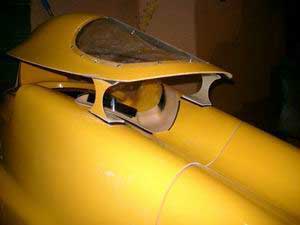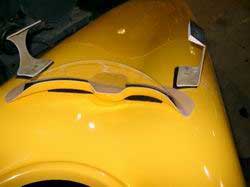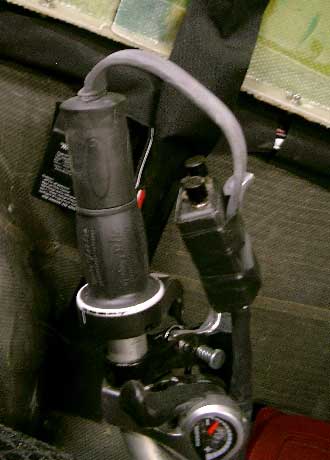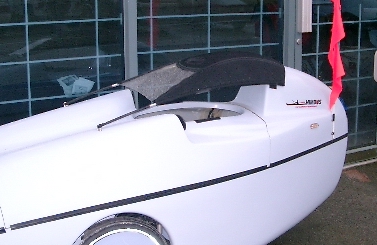
 |
| Homepage • Products • Contacts Us |
October 27, 2007
A couple of pictures of the
latest improvemnets to the Aurora
The roof is now held on with velcro so that removing it can now be done without tools. I have taken it off and on quite a few times now and this is a welcome change.

Here is the change to the windscreen. There is now a small indent in the FRP part to let air flow on the backside of the lexan piece. Hopefully this should help to keep it from fogging up. The lexan piece is held on with velcro so it is removeable if you don't need it. I can easily remove it even when riding.

Here is a view of the nose of the Aurora showing the signal and headlight arrangement. The headlights which still need to be installed sit behind the flush lexan covers. I am quite impressed with the performance of the Nite Hawk headlights.

The throttle on the latest Aurora with the arangement we have come up with to keep the turn signals switches handy. I have been using it in the Borealis as I have a twist shitfter for the front derailleur and find it very conveniently placed. Also note the parking brake which is the button sticking out of the brake handle for the front wheel.
.
Here is a shot of the slightly modified derailleur cover. The bottom of the cover is slit almost off so it can pivot up and allow a bit more clearance. I have bashed up a couple of covers so far so the extra inch of clearance will solve this problem. The hinge is a part of the laminate that has some polyester fabric oriented to allow bending. It is similiar to the hinge we use for attaching the door. Note the small slot to allow any water that gets in to run out, as any water that gets in the footwells seems to end up here.
October 29, 2007
When I started out making the Borealis I just wantd to try out a tadpole velomobile. When Trice came out with their standard line of trikes with suspension I thought that there was a reasonable possibility of having a very useable velomobile by adding a fairing to the trike. I have tried with the Kettweisel to do this and found that to be acceptable to most cyclists you needed some suspension to keep the shell from being too noisy. The Aurora was the result of adding suspension to the basic geometry of the Kettweisel. Another the reason is that tadpole trikes are more popular and there has been a far bit of interest so far. Besides, from the bit I have used on theBorealis so far, it is a worthwhile addition to the QNT and increases the utility of the trike. Lots of fun too. Having a shell available that fits a very nice trike could help get more velomobiles in use--if you already have the trike the investment is not as great as for a stand alone velomobile.
Have decided to proceed with modifying the Borealis to make available as a shell to fit onto the Trice QNT. Hopefully we can have it done for next Spring. The major change is that the nose will be shortened to make it a bit more compact. The top will be made in three sections while the bottom will be in two sections so the parts can be nested for shipping. Have no firm idea of the cost yet but the hope is to to be able to make a first rate shell for about the same price as the trike it fits on.

Have installed the Flevobike roof on the Borealis. Waterdrops get blown under the cover and land on my glasses. Visibility under the roof is good and the roof will fit inside the velomoible. It needs a small windscreen similar to that on the Aurora to be more effective. The ultimate goal would be to have a roof that is made of fabric and can be quickly disassembled and stored in a minimum of space. We think we have figured out how to make a tensioned fabric structure and now only need the time to implement it.
The other big issue with riding in the rain is water coming in through the open wheel wells. We have fairly full coverage fenders which keep almost all the water out. The addition of a fabric cover on the inside of the wheel well will make it very dry. These will be removeable as the wheel wells do provide a bit of ventilation. I am also changing the inside of the wheel well to decrease the turning radius and build in some extra stiffness by adding more shape. Still have to make sure the mounting system to the trike is good for carrying loads and to completely enclose the rear wheel.